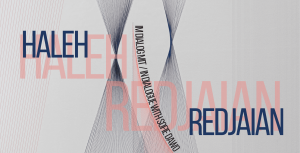The exhibition “From Fiber to Form” traces the development of textile art in Germany from the 1960s to the 1970s and anchors it in its art-historical context. The focus is on the development from the pictorial nature of wall hangings to the increasing relief-like structuring of textile surfaces and the conquest of three-dimensional space. In…
 Image: Haleh Redjaian. Out of Line, 2021, dimensions variable, nails, threads, steel frame, (detail). © April Morais, VG Bild-Kunst, Bonn
Image: Haleh Redjaian. Out of Line, 2021, dimensions variable, nails, threads, steel frame, (detail). © April Morais, VG Bild-Kunst, Bonn
Haleh Redjaian, born in Frankfurt am Main in 1971, studied at the Academy of Fine Arts in Antwerp. The basis of her drawings, textile works, and installations consists primarily of repetitive grids, patterns and networks, which she creatively reshapes and reworks. At the center of her work is always the line, whether drawn on paper,…
With the cabinet exhibition »Paul Strecker – Magic of the Curtain« the Kunsthaus Dahlem shows works of the unusual and versatile artist. His work includes paintings, drawings and stage designs as well as literary texts. In addition, as a teacher and critic, he influenced art history in his adopted home of Paris, where he lived…
Peter László Péri (1899–1967) emigrated from Berlin to London in 1933 – persecuted for racial and political reasons, the capital was no longer a home for the Hungarian-born artist after the National Socialists took power. He had worked in Germany from 1920 to 1933. The renowned gallery owner Herwarth Walden exhibited his concrete and wooden…
»Sculptures and reliefs have been cast in concrete ever since the beginning of its use for building, but modelling in concrete is comparatively new. After many years of experiment, I have found that this method of modelling has many advantages. The sculpture which gets stone hard during the process of modelling retains the freshness of…